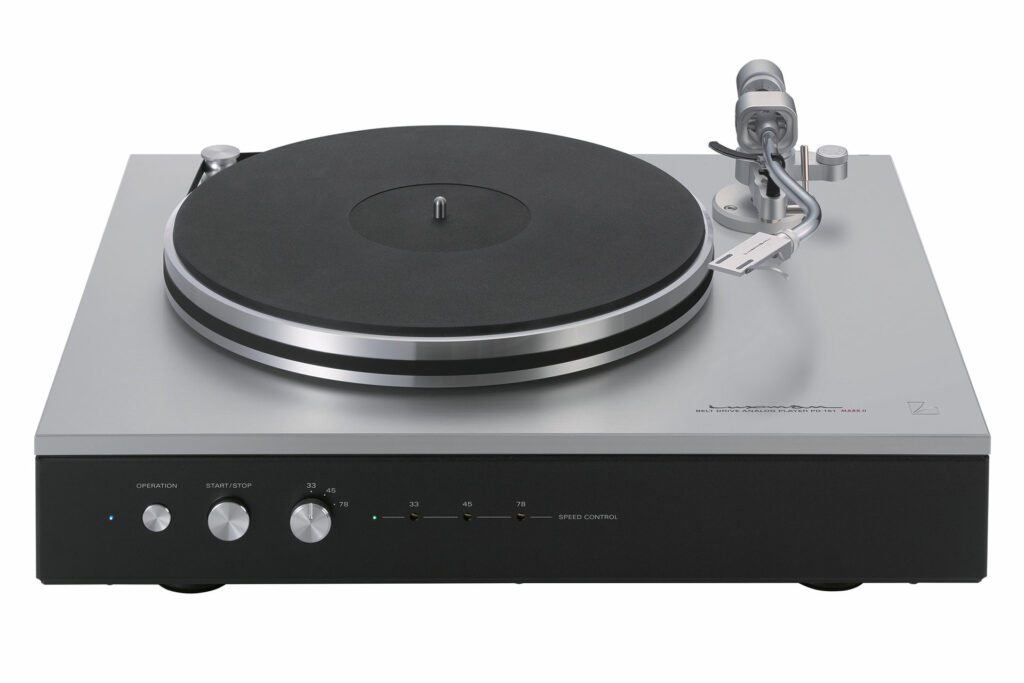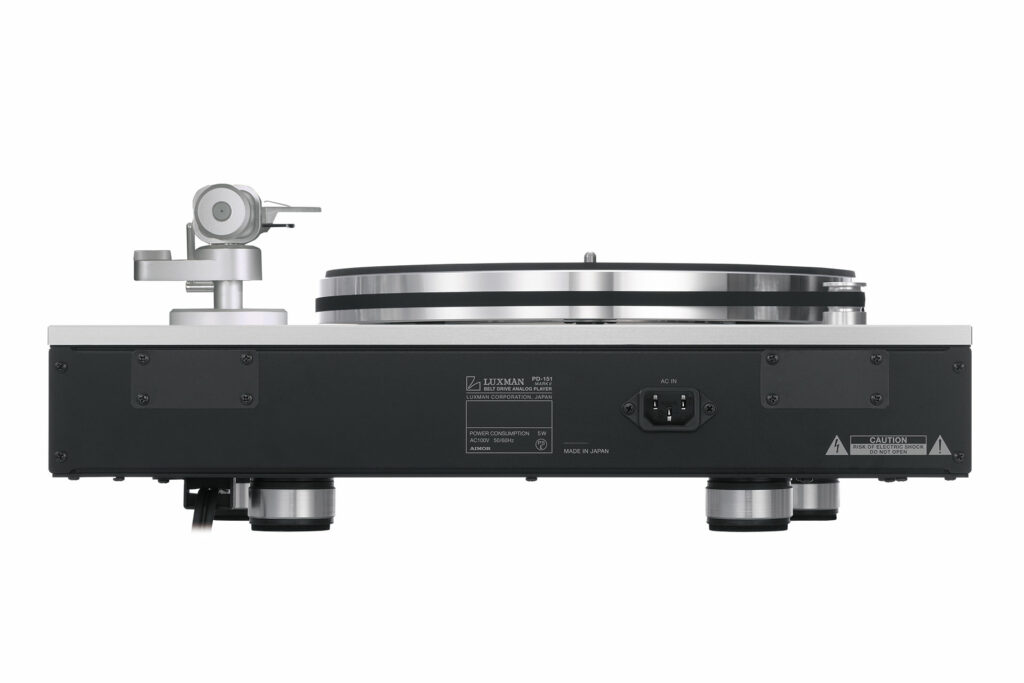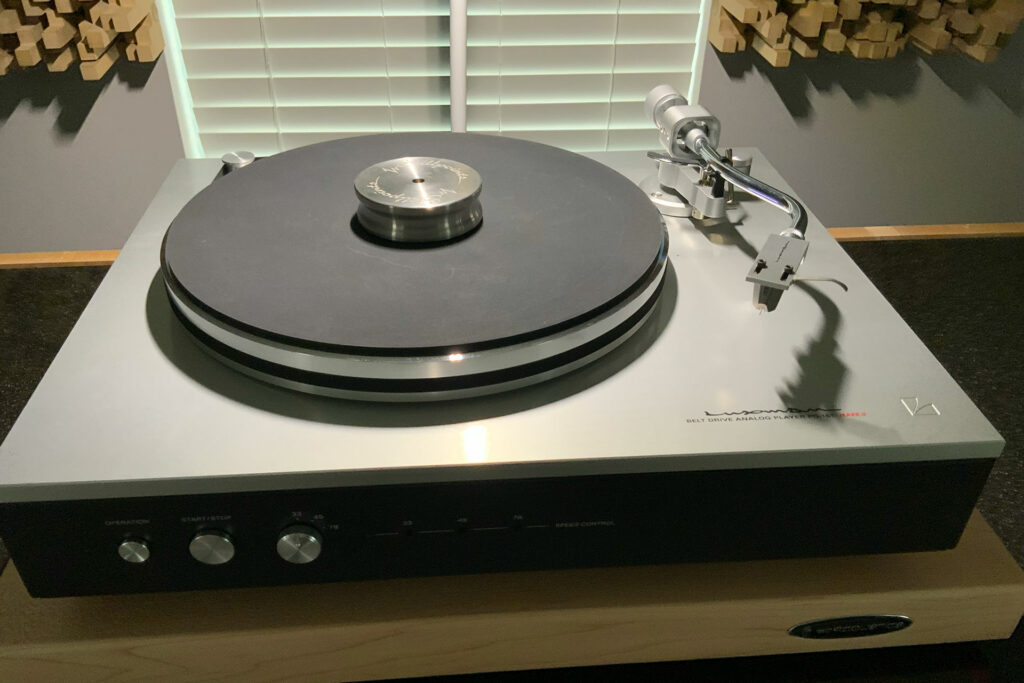Luxman Corporation has a solid reputation for very high build quality, and while not necessarily or even exclusively budget oriented, their products are not out-of-reach expensive. Such is the case with the recently released Luxman PD-151 Mark II audiophile turntable. As with any newly designed product, challenges must inevitably be overcome. Central to Luxman’s challenges were dealing with the fact their longtime tonearm manufacturer, the highly regarded Jelco, shut down production after almost 100 years of operation. This required Luxman to find a new tonearm supplier, which was successfully accomplished with Japanese manufacturer SAEC. This partnership led to the creation of the proprietary LTA-309 tonearm now included on the Mark II design.
Visually, the Luxman PD-151 Mark II exudes simple elegance. Fit and finish are excellent, as evidenced by a brushed aluminum plinth perched atop a polished black base. Everything about this turntable exudes simple quality, an attribute I suspect Luxman was trying to achieve. This turntable is not in any way an ultra-modern design, as are many of today’s pricier offerings. Neither is it a throwback to a design aesthetic from the last century. It is both somewhat retro and somewhat modern, and when any non-audiophile looks at it, they will immediately know what it is: a well-built, high-quality turntable.

What Makes the Luxman PD-151 Mk II Special?
- Most of the functional parts – such as the motor, power supply, main bearing and speed control circuitry – are mounted inside the base. This help maintain a stylish yet classic appearance.
- To combat unwanted vibrations, the motor and transformer are mounted on custom-designed rubber insulators to isolate these components from direct contact with the plinth.
- There are four independently adjustable composite rubber polymer insulator feet on the bottom to ensure the deck is completely level and provide additional dampening.
- A slightly wide, flat belt between the motor pulley and platter ensures increased contact and virtually no slippage as opposed to the thin, round belts used on some turntables.
- To further reduce unwanted vibrations, Luxman uses an ultra-quiet DC brushless motor rather than the AC synchronous motors commonly found in many turntables. I put my ear as close to the motor as possible and did not hear anything at all. With or without the platter, the motor is totally silent. This is a very positive harbinger that playback will not be distorted by unwanted motor noise.
- To help achieve rotational accuracy, Luxman uses a highly sophisticated sinewave/Pulse Width Modulation power supply to provide current to the DC brushless motor drive system.
- A custom-designed Proportional-Integral-Differential feedback loop was developed to constantly monitor and preserve rotational accuracy of the platter.
- Platter rotational speed accuracy or pitch may be controlled to plus or minus six percent with an adjustable set screw on the front of the turntable. When an acceptable speed has been achieved, the speed indicator shows solid green. When blinking green the platter is running slow and running fast when blinking blue. Using the RPM platter speed app, a program using an iPhone’s internal gyro to provide real-time platter speed, I was able to check the speed of the turntable. Based on the nominal speed of 33-1/3 (33.33), my factory set platter speed measured 33.55 RPM. This represented a variation of 0.65 percent too fast. After a quick adjustment, I was able to improve measured speed to 33.34 RPM, or 0.01 percent too fast. Granted, there are platter-speed measuring devices much more accurate than an iPhone app. It is therefore up to the user to determine which measurement tools are or are not acceptable.
- A small screwdriver is conveniently included to affect any requisite speed adjustments.
- There are three speeds available on this turntable: the obligatory 33-1/3 RPM, the increasingly popular 45 RPM, and, somewhat surprisingly, 78 RPM. I don’t know many people playing 78s these days, but if you wanted to do so, you can.
- The power, start-stop and speed adjustment buttons are on the front of the base. At first, I was suspicious of their placement but quickly discovered I liked where they were located just fine.
- The Luxman LTA-309 tonearm designed in cooperation with SAEC is quite simple to configure. Using a knife-edge bearing technology and a machined arm base to reduce contact area, the tonearm is both rigid and inert.
- At the end of the S-shaped tonearm is an H4 bayonet-style removable headshell with a locking collar. This allows the cartridge to be mounted to the headshell, connected to the wires, yet still be removed. It also makes attaching the cartridge much easier.
- Mounting a cartridge to the tonearm is mostly simple. As opposed to other turntables I’ve owned where cartridge setup has taken a couple hours of frustrating effort, the Luxman PD-151 was pleasantly uncomplicated. From the time I unpacked the shipping container until I was ready to play music took about an hour. In fact, I only cursed one time – much better than some of my past turntable tirades…
- A platter mat is included. Use of one is a hotly debated issue. On my other turntable, A VPI Classic Signature, I do not use one, as I feel it overly dampens sonics. I do not get the same impression with the Luxman-supplied mat, as using it delivers an open and dynamic presentation. Use of a platter mat and which one is a user preference so I make no recommendations one way or another. My only observation is I did not find the Luxman platter mat delivered a deleterious sonic effect.

Why Should You Care About the Luxman PD-151 Mark II?
We live in a world where turntables range in price from about a $150 all the way to the stratospheric cost of a $500,000. At any price, turntables continue to gain popularity among all audiophiles, particularly younger listeners. This turntable is extremely well designed and engineered for the price. It offers superior sonics, simple setup and operation, all the while exuding a visually elegant design. While not the least expensive, and clearly not the most, the Luxman PD-151 Mark II delivers an exceptional user experience for the price.

Some Things You May Not Like About the Luxman PD-151 Mark II…
- While Luxman conveniently includes a factory mounted cable to connect the tonearm to a phono stage, changing the cable is quite difficult. On the tonearm base end is a female DIN connector with male RCA terminals on the other. It connects under the turntable and is held fast on the bottom by a screw-down bracket. I would far prefer RCA connectors easily accessible on the turntable end. Accessing the Luxman cable means practically turning the whole unit upside down – or on its side, at the very least. I would rather use my Nordost Valhalla 2 tonearm cable but I cannot due to incompatible terminations and the difficulty of the location of the tonearm cable.
- It is not possible to adjust the vertical tracking angle while the turntable is in use. The Luxman PD-151 utilizes a locking set screw design and it must be loosened and the tonearm height manually adjusted by hand before the set screw is retightened. Many turntables today utilize a precise on-the-fly adjustment of the VTA to accurately adjust tonearm height and accommodate LPs of different thicknesses.
- Some analog purists might feel that the bayonet mount on the headshell allows for sufficient variation that highly repeatable and accurate azimuth settings are difficult at best. How much this may matter is dependent on how detailed the user regards setup. Anyone using a microscope and sophisticated software for dialing in azimuth, VTA, stylus rake angle, and all other settings may take issue with a locking collar headshell because of potential variances that may be realized when attaching it to the tonearm.
- The dust cover is not included and must be purchased separately for $795.
Listening to the Luxman PD-151 Mark II Turntable…
I typically clean an LP in a KLAudio Ultra Sonic record cleaner before playing. I then use an AudioQuest Carbon Fiber Brush to make one last pass at the LP. Every so often, I swipe the stylus with the brush included with my Ortofon MC Verismo cartridge. Lastly, I use a Stillpoints LPI Record Clamp to assist in LP flatness. (Note: I use the original LPI; a new Version II is now available.) I do these things to help ensure LP playback is refined as possible. There are, however, different practices among audiophiles and mine is only one of them. Generally speaking, using the above process on all LPs, I found playback of the Luxman PD-151 Mark II to be highly engaging. My system tends to be very revealing, and with this analog setup, poor recordings were easily identifiable. I consider this an attribute and something I expect to hear, not hope to hear. I found the overall sonics to be detailed, with excellent dynamics and excellent portrayal of the natural analog character of my better LPs.
I wanted to give the turntable a real test, so on purpose, I chose “Smoke On The Water” from Deep Purple’s landmark album Made In Japan. I originally purchased this album in 1973. I cannot even guess what this album has been through. After cleaning, I was shocked to discover it was nearly silent, with almost no pops or clicks. Ritchie Blackmore’s guitar and Roger Glover’s bass played off each other and portrayed that famous opening with magnificent definition and dynamics. When the hi-hat comes in, it imaged to the far right and was in no way compressed. I was having such a good time I cranked it up to about 95 dB, something I rarely ever do.
Next, I chose “What’s Going On” from the LP of the same name by Marvin Gaye. This work is a 2008 remastered version and his landmark album expressing frustration with the Vietnam War and how drugs had ravaged young people in the US. With this very natural analog presentation, the pleading for change could almost be heard in his voice as he sang. The alto sax is in rare form, James Jamerson’s bass work is perfect, as are the Motown house band, The Funk Brothers. Motown in the ’70s was dedicated to sonic quality and this track is emblematic of that commitment. On my system, it was musically accurate, highly detailed, and the imaging was spot-on precise. There was a naturalness to the blend between the low frequencies, the mids, and highs that actually caused me to become so absorbed in the music I completely forgot I was doing a review.
Does the Luxman PD-151 Mark II Have Any Resale Value?
I suspect once purchased, most turntable owners keep them for quite a few years and change the cartridge more often than the table itself. Resale value may therefore be partially based on availability of used components. Resale price is determined by the original MSRP and the age and condition of the unit. When looking online, I found generous numbers of used turntables from recognizable brands such as Linn, Technics, and VPI. I also found a few older model Luxman turntables but I did not see any used PD-151 Mark II units available. Perhaps this is due to the relatively new mid-2022 release date. Or maybe it is because owners of these turntables have yet to find a reason to part with them. However you look at it, resale value should be excellent as market saturation for a used PD-151 Mark II is exceedingly low.
Who Is the Competition for the Luxman PD-151 Mark II Turntable?
- At $6,299 depending on tonearm, plinth color, and several other options, the VPI Classic Signature (read the review) is a very close competitor. This turntable has received very favorable reviews over the years and is considered a legacy product for VPI. It uses an AC synchronous motor as opposed to Luxman’s DC brushless motor. With both in my audio room, the Luxman was the quieter of the two. Both achieved accurate platter speed readings. Luxman uses a machined aluminum platter whereas VPI is using one machined from aluminum and stainless steel. The VPI platter is considerably heavier at about 20 pounds as opposed to Luxman’s nine-pound weight. Overall, the VPI is much heavier at almost 70 pounds versus nearly 34 pounds for the PD-151 Mark II. Setup using a VPI Unipivot tonearm is more difficult than the Luxman/SAEC tonearm. Having owned both turntables, each one produces a very enjoyable sound given an equivalent cartridge.
- Way back in 1972, Scotland based manufacturer Linn introduced the Sondek LP12 turntable. It holds the distinction of the longest continuously produced turntable, now 51 years and counting. There are three versions and the Linn Majik, at a cost of $5,130, is the closest in price to the Luxman PD-151 Mark II. Linn utilizes a suspended chassis, and despite the many refinements made in the last half century, this basic design tenet has remained constant. The LP12 is highly customizable and based on alterations or better versions can cost upwards of $30,000. One major difference between both tables is the difficulty of setup. Linn recommends an authorized dealer configure the turntable. There are special fixtures and tools dealers have that are necessary to properly assemble an LP12. Setup may easily take four hours or more. I find each turntable has an excellent, even beguiling sonic presentation and either one would be welcomed in my audio room.

Final Thoughts on the Luxman PD-151 Mark II Audiophile Turntable
There are enough turntables these days, each magnificently engineered and sonically outstanding, that choosing one over all the others has become quite difficult even for the seasoned audiophile. There are price points to fit any conceivable budget. There is a wide assortment of designs, all intended to call attention to themselves. It would be quite easy, by contrast, to pass the Luxman PD-151 Mark II by without much notice. This would be an unfortunate mistake.
Looking at the innovative, even superior design compared to the retail price, considering the features and benefits, and, most importantly, considering the excellent sonics rendered by this turntable, it is a real standout in the ~$6,000 price range. I found the Luxman PD-151 Mark II to be both simple to set up and use. I found it to have a captivating sonic presentation and, most of all, I have absolutely enjoyed having it in my system. I could spend more, actually a lot more for a turntable. For my own purposes, the Luxman PD-151 Mark II checks almost all the boxes for a superior analog LP experience. I can therefore strongly recommend a demo to anyone in the market for new turntable in this price class. It is the culmination of a rethinking by Luxman on how to design a turntable. This new design ethos has delivered an excellent product and one easily welcomed in most any audio system. It sure is in mine.




This is how a turntable should look and feel…
Most ‘reference’ turntables don’t consider domestic aesthetics.